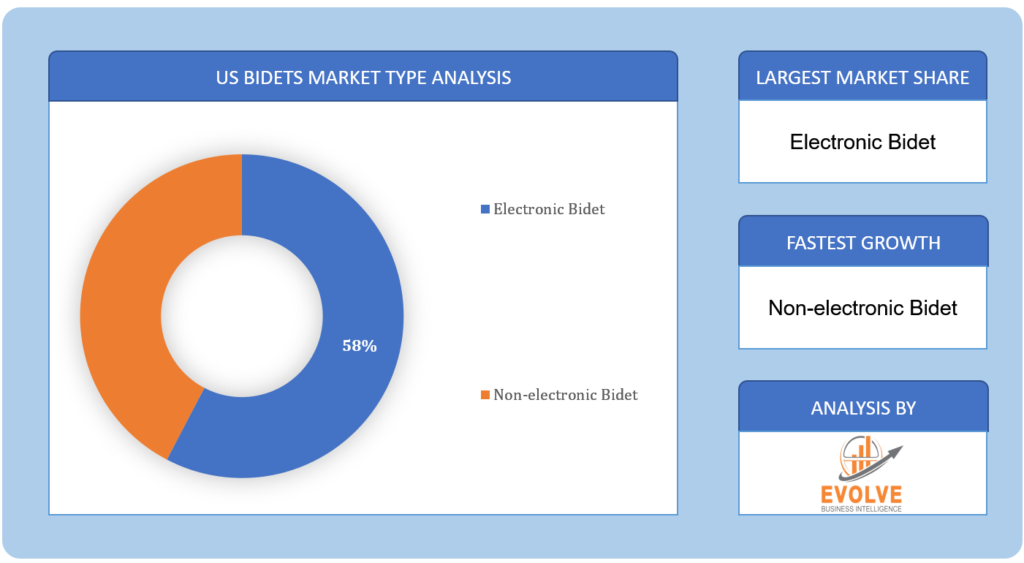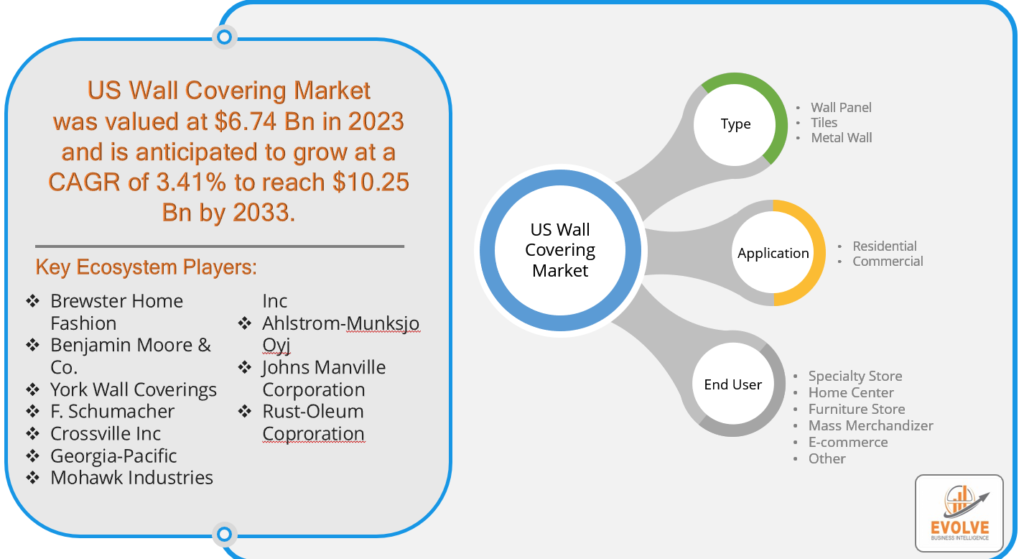Wall Covering Market Analysis and US Forecast 2023-2033
$1,390.00 – $5,520.00Price range: $1,390.00 through $5,520.00
Wall Covering Market Research Report: By Type (Wall Panel, Tiles, Metal Wall), By Application (Residential, Commercial), By End User (Specialty Store, Home Center, Furniture Store, Mass Merchandizer, E-commerce, Other), and by Region — Forecast till 2033
[vc_row][vc_column width=”2/3″][vc_column_text woodmart_inline=”no” text_larger=”no”]Wall Covering Market Overview
The US Wall Covering Market Size is expected to reach USD 10.25 Billion by 2033. The US Wall Covering industry size accounted for USD 6.74 Billion in 2023 and is expected to expand at a CAGR of 3.41% from 2023 to 2033. Wall covering refers to any material or substance employed to adorn and protect the interior or exterior walls of a structure. Serving both utilitarian and aesthetic functions, wall coverings enhance the visual appeal of a space while safeguarding walls from wear and tear. These coverings come in a myriad of forms, ranging from traditional choices like paint and wallpaper to contemporary alternatives such as wood paneling, fabric, tile, stone, or textured finishes. The selection of a specific wall covering depends on factors such as design preferences, intended functionality, and budget constraints. Overall, wall coverings play a pivotal role in shaping the ambiance and character of a room or building.
US Wall Covering Market Synopsis
The US Wall Covering market faced a moderate impact from the COVID-19 pandemic. The initial phases of the crisis brought disruptions, including supply chain challenges and project delays, leading to a temporary slowdown. However, the market demonstrated resilience as the pandemic persisted, with increased demand for home improvement projects and a surge in DIY activities. With more individuals spending time indoors, there was a noticeable shift in consumer focus towards enhancing living spaces, contributing to a recovery in the market. E-commerce channels played a crucial role in facilitating sales, and manufacturers adapted by introducing innovative designs and materials to align with changing consumer preferences. Despite the challenges posed by the pandemic, the US Wall Covering market displayed adaptability and ultimately rebounded as the industry embraced evolving trends in home aesthetics and lifestyle.
US Wall Covering Market Dynamics
The major factors that have impacted the growth of Wall Covering are as follows:
Drivers:
⮚ Growing Home Improvement Trends
The increasing focus on home improvement activities emerges as a significant driver for the US wall-covering market. As more individuals spent time at home during the COVID-19 pandemic, there was a heightened emphasis on enhancing living spaces, driving demand for aesthetically pleasing and functional wall coverings. The trend toward DIY projects further propelled market growth, as consumers sought cost-effective ways to refresh their interiors, contributing to sustained demand for a variety of wall covering options.
Restraint:
- Supply Chain Disruptions
The US Wall Covering market was the impact of supply chain disruptions caused by the COVID-19 pandemic. Lockdowns, restrictions, and global logistical challenges led to delays in the procurement of raw materials and distribution of finished products. These disruptions initially hindered the industry’s ability to meet demand promptly and created uncertainties in project timelines, influencing the overall market performance.
Opportunity:
⮚ Technological Innovation and E-commerce Adoption
The opportunity within the US Wall Covering market lies in technological innovation and the increasing adoption of e-commerce channels. Manufacturers have the opportunity to leverage advancements in materials and design techniques to offer innovative wall-covering solutions that cater to evolving consumer preferences. Simultaneously, the growing popularity of online platforms provides a significant avenue for market players to expand their reach, engage with consumers directly, and streamline distribution processes, presenting a promising opportunity for sustained market growth.
Wall Covering Market Segment Overview
By Type
 Based on the Type, the market is segmented based on Wall Panel, Tiles, and Metal Wall. The Wall Panel segment was anticipated to dominate the Wall Covering market, holding the largest market share, driven by its versatile applications, aesthetic appeal, and increasing demand for modern interior design solutions.
Based on the Type, the market is segmented based on Wall Panel, Tiles, and Metal Wall. The Wall Panel segment was anticipated to dominate the Wall Covering market, holding the largest market share, driven by its versatile applications, aesthetic appeal, and increasing demand for modern interior design solutions.
By Application
Based on the Application, the market has been divided into Residential and Commercial. The Residential segment is poised to claim the largest market share in the Wall Covering market, driven by rising home improvement trends, increased discretionary spending on interior aesthetics, and a growing emphasis on personalized and visually appealing residential spaces.
By End User
Based on End Users, the market has been divided into Specialty Stores, Home Centers, Furniture Stores, Mass merchandisers, E-commerce, and others. The Specialty Store segment is anticipated to secure the largest market share in the Wall Covering market, attributed to its ability to provide a diverse range of specialized and curated wall-covering options, offering consumers a unique and tailored shopping experience in line with evolving design preferences.
Competitive Landscape
The competitive landscape includes key players (tier 1, tier 2, and local) having a presence across the globe. Companies such as York Wall Coverings, F. Schumacher, Crossville Inc., Georgia-Pacific, and Mohawk Industries Inc. are some of the leading players in the US Wall Covering Industry. These players have adopted partnership, acquisition, expansion, and new product development, among others as their key strategies.
Key Market Players:
- Brewster Home Fashion
- Benjamin Moore & Co.
- York Wall Coverings
- Schumacher
- Crossville Inc
- Georgia-Pacific
- Mohawk Industries Inc
- Ahlstrom-Munksjo Oyj
- Johns Manville Corporation
- Rust-Oleum Corporation
Key development:
In April 2022, Georgia-Pacific’s lumber business announced a collaboration with leaders in the mass timber industry for the construction of a new office building within Atlanta’s renowned Ponce City Market development. The project aims to support the development of a four-story mass timber loft office building, boasting 90,000 square feet of office space and 23,000 square feet of ground-level retail space. The building is designed to be LEED-certified and operate with net-zero carbon emissions.
In May 2021, Crossville introduced large-format tile panels to the United States market through the nationwide launch of “Laminam by Crossville.” This launch results from an exclusive distribution agreement between Crossville and Laminam, making Crossville the exclusive source for Laminam’s 3+ products—innovative, 3mm-thick surfacing tiles—across the United States. The distribution agreement took immediate effect, ensuring the widespread availability of the products.
Scope of the Report
US Wall Covering Market, by Type
- Wall Panel
- Tiles
- Metal Wall
US Wall Covering Market, by Application
- Residential
- Commercial
US Wall Covering Market, by End User
- Specialty Store
- Home Center
- Furniture Store
- Mass Merchandizer
- E-commerce
- Other
US Wall Covering Market, by Region
- North America
- US
- Canada
- Mexico
- Europe
- UK
- Germany
- France
- Italy
- Spain
- Benelux
- Nordic
- Rest of Europe
- Asia Pacific
- China
- Japan
- South Korea
- Indonesia
- Austalia
- Malaysia
- India
- Rest of Asia Pacific
- South America
- Brazil
- Argentina
- Rest of South America
- Middle East & Africa
- Saudi Arabia
- UAE
- Egypt
- South Africa
- Rest of Middle East & Africa
| Parameters | Indicators |
|---|---|
| Market Size | 2033: $10.25 Billion |
| CAGR | 3.41% CAGR (2023-2033) |
| Base year | 2022 |
| Forecast Period | 2023-2033 |
| Historical Data | 2021 |
| Report Coverage | Revenue Forecast, Competitive Landscape, Growth Factors, and Trends |
| Key Segmentations | Type, Application, End User |
| Geographies Covered | North America, Europe, Asia-Pacific, Latin America, Middle East, Africa |
| Key Vendors | Brewster Home Fashion, Benjamin Moore & Co., York Wall Coverings, F. Schumacher, Crossville Inc, Georgia-Pacific, Mohawk Industries Inc, Ahlstrom-Munksjo Oyj, Johns Manville Corporation, Rust-Oleum Corporation |
| Key Market Opportunities | • Leveraging technological advancements for innovative wall covering solutions. • Expanding reach and engaging consumers through online platforms. |
| Key Market Drivers | • Increased focus on home improvement activities. • Rise in DIY projects as consumers spend more time at home. |
REPORT CONTENT BRIEF:
- High-level analysis of the current and future Wall Covering Industry trends and opportunities
- Detailed analysis of current market drivers, restraining factors, and opportunities analysis in the future
- Historical market size for the year 2021, and forecast from 2023 to 2033
- Wall Covering market share analysis for each segment
- Competitor analysis with a comprehensive insight into its product segment, financial strength, and strategies adopted.
- Identifies key strategies adopted by the key players including new product development, mergers and acquisitions, joint ventures, collaborations, and partnerships.
- To identify and understand the various factors involved in the US Wall Covering market affected by the pandemic
- To provide year-on-year growth from 2022 to 2033
- To provide short-term, long-term, and overall CAGR comparison from 2022 to 2033.
- Provide Total Addressable Market (TAM) for the US Wall Covering Market.
[/vc_column_text][/vc_column][vc_column width=”1/3″][vc_column_text woodmart_inline=”no” text_larger=”no”][html_block id=”3961″][/vc_column_text][vc_wp_text]<p class=”Release”>Press Release</p>
[rpwe limit=”10″ thumb=”true”][/vc_wp_text][/vc_column][/vc_row][vc_row][vc_column][vc_column_text woodmart_inline=”no” text_larger=”no”]
Frequently Asked Questions (FAQ)
[sp_easyaccordion id=”12776″][/vc_column_text][/vc_column][/vc_row]




